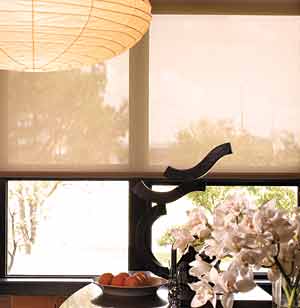Daylight in the Office Space
Roller Shades
Roller shades reduce solar heat gain, UV penetration, and glare, while preserving the view to the outdoors. This valuable multi-tasking ability occurs when translucent shade fabric is used, acting as a finely woven light filter. The weave is so fine that the eyes move past it to the view beyond, while the fabric threads diffuse, absorb, or reflect the unwanted solar energy.
|
||||||||||||||
One thing to consider is that view can be two-sided. During the day, shades can provide building occupants with outdoor views. At night, if the interior of the building is sufficiently illuminated, it will be visible from the outdoors.
Curb Appeal is a Matter of Control
Curb appeal is not a strength of manual control. The ability to provide a consistent look from the outdoors is based on a system's ability to establish and maintain a uniform position for each component. Both blinds and shades can be manually controlled to accommodate differences in employee preference, time of day, and task. Placing the power of position in employees' hands is rarely conducive to achieving a consistent product height throughout an office space. When controlled manually, each blind or shade throughout a building can be positioned uniquely-up, down, or tilted, depending upon the preference, skill, and patience of the last operator.
Both horizontal louvers and roller shades can be automated or centrally controlled. The position and tilt of horizontal louvers can be controlled via automation. Automation guarantees that each shade is always positioned appropriately for maximum effectiveness and offers the opportunity for consistent curb appeal by programming shades to uniform, pre-determined heights throughout the building.










